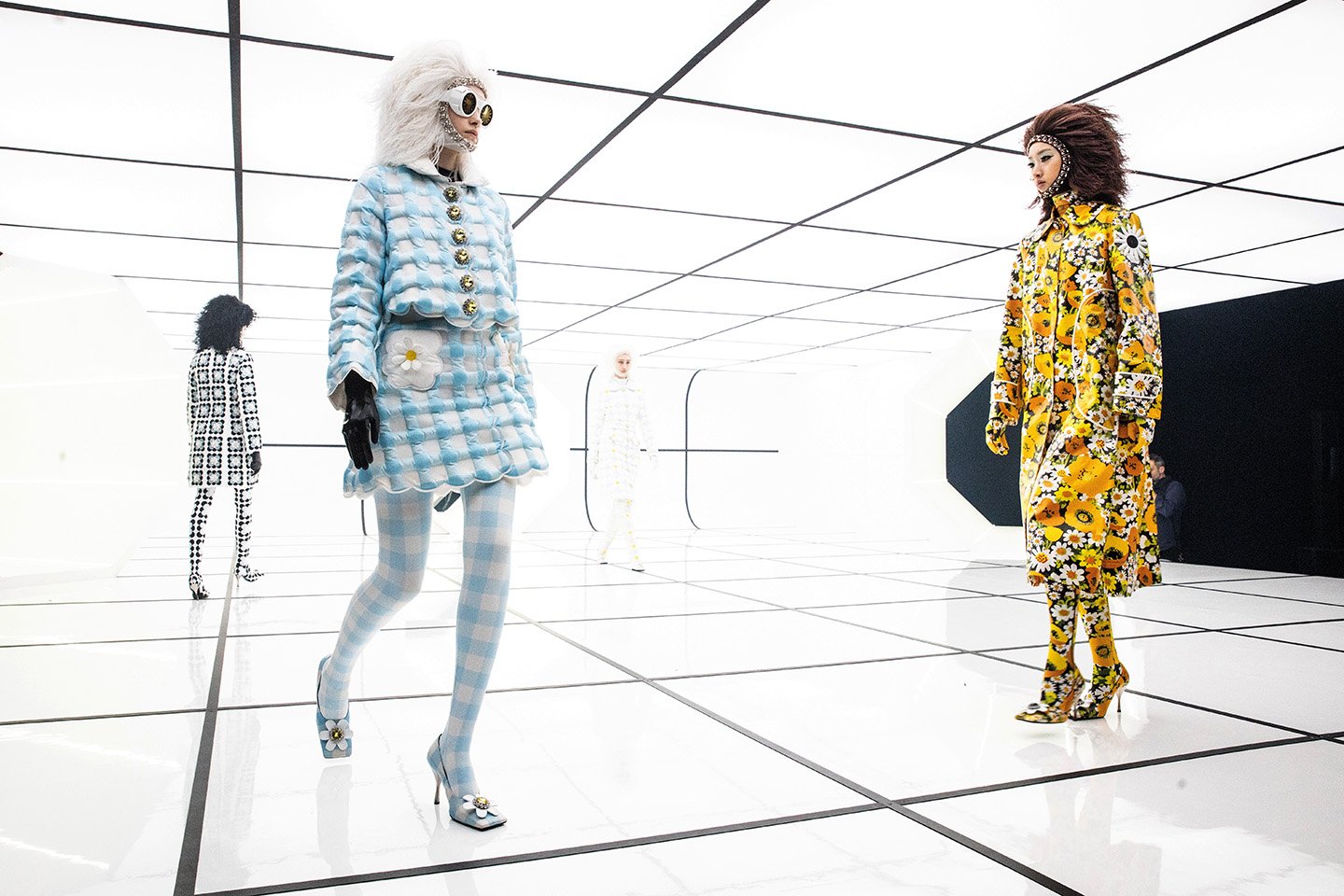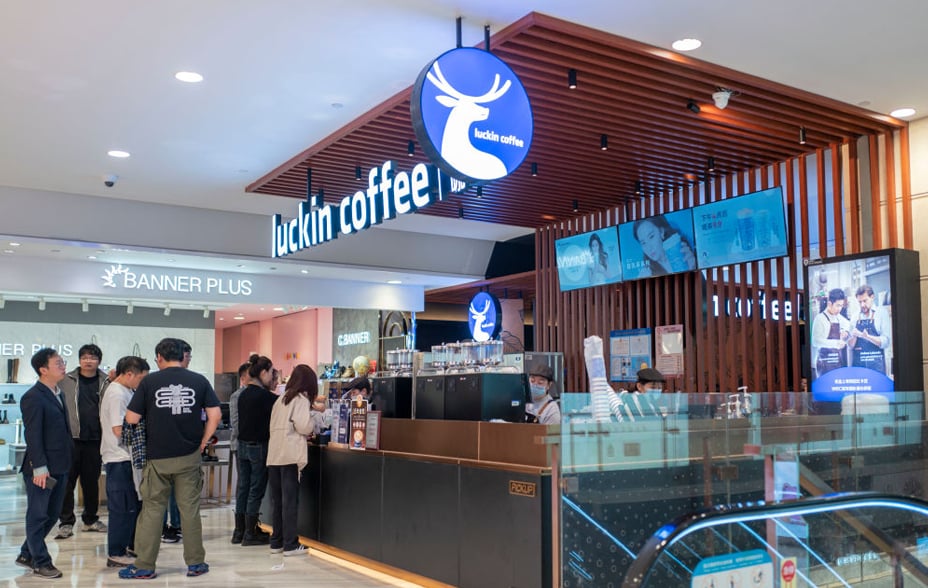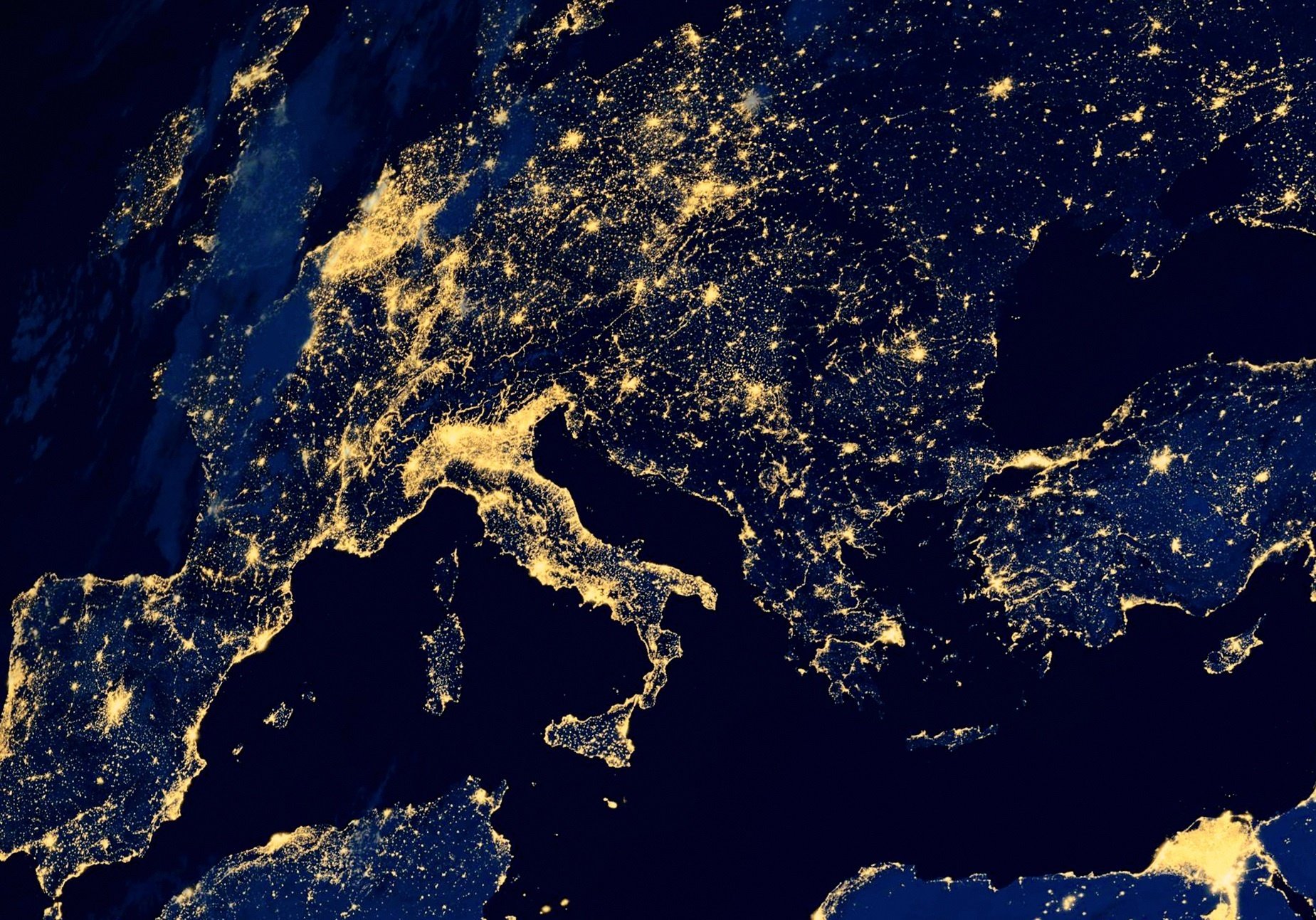
High peaks to high fashion: Moncler models at Milan Fashion Week, 2020. Images © Getty Images Europe
Please remember that the value of an investment can fall and you may not get back the amount invested.
Near the entrance to Moncler’s London flagship store at 26 Old Bond Street, between jewellers Tiffany & Co and fashion house Alexander McQueen, a pair of vintage skis is on display. Beside them is a showcase containing well-worn helmets and goggles. The message? We may have earned our place in one of the world’s chicest streets, but we were ‘born in the mountains’.
With that Alpine provenance implanted in their minds, shoppers face walls and racks hung with super-light ski jackets, winter coats, gilets, sweaters and elegant seamless wool skirts. White, cream and black are the predominant colours, with an occasional splash of cobalt blue or bright orange. All items carry Moncler’s logo, featuring a cockerel in the colours of the French flag (although the firm has long been Italian-owned) entwined with the ‘M’ monogram.
Price tags range from about £600 to £2,500 and upwards. The garments are beautifully made, drawing on the firm’s tradition of innovation in fabric technology. Shopworkers discreetly tidy ruffled items, enacting the brand’s fastidious attention to detail.
Alpine roots
The Moncler story goes back to 1952, when the company began making sleeping bags and down jackets to protect against the worst of the Alpine weather.
“Even before mountaineering was a big thing, Moncler was kitting out famous mountaineers such as Lionel Terray, who worked with the firm to create a line carrying his name,” says Chris Davies, who invested in Moncler last year.
“The heritage that ‘born in the mountains’ reinforces is part of its DNA, but technical innovation has always been just as important. It helps Moncler find that sweet spot of being both a practical and a luxury purchase.”
The European Growth Team is impressed by the company’s leader, Remo Ruffini. In the two decades of the Italian billionaire’s stewardship, Moncler has become one of the fastest-growing luxury brands in the world. Davies challenges me to name another relative newcomer that has elbowed its way up so quickly to rank with the great luxury and fashion house brands.
Standing out
The advance has been thanks to Ruffini’s vision but also owes much to the ‘casualisation’ trend in fashion that has given outerwear such catwalk credibility and makes Moncler attractive to Gen Z and millennials, as well as older aspirational customers.
Under Ruffini’s leadership, Moncler has created a distinctive category, somewhere between upmarket brands, such as Canada Goose, and more venerable houses, such as Chanel, Gucci, Dior and Prada.

By next year, Moncler pledges to use 50 per cent recycled nylon and 100 per cent organic cotton in its puffers and other products.
Fashion is fickle, and some analysts see Moncler’s edge coming under a pincer attack: from luxury brands muscling in on its casual territory and from streetwear brands acquiring luxury status. But its mountain heritage is hard to replicate.
“Most of the big, successful luxury houses just got bigger and bigger as time went by,” Davies says. “Moncler compounded its brand advantage through continued reinvestment. It found some kind of secret sauce and broke through the high barriers to the luxury market.”
The garments are beautifully made, drawing on the firm’s tradition of innovation
Ruffini moved Moncler away from selling through sportswear stores and wholesalers to exclusive boutiques. In 2008, five years after he had bought the brand from a struggling fellow Italian entrepreneur, the company opened a flagship store on Paris’s super-chic Rue du Faubourg Saint-Honoré. Just five years later, its shares were listed on Borsa Italiana, Milan’s stock exchange.
Visionary leadership
It might not have turned out this way. Moncler was almost bankrupt when Ruffini bought it. The 62-year-old leader is the product of a three-generation textiles and clothing dynasty from Como and now owns 23 per cent of the company. He is responsible for the restless energy of its culture.
Unlike the big fashion brands, Moncler doesn’t rely on a single superstar designer but has created an extraordinarily diffuse creative platform. This includes its Moncler Genius programme, which invites multiple big-name design partners to contribute creative ideas.
Regular monthly collaborations feature guest designers such as Valentino’s Pierpaolo Piccioli, Craig Green, Simone Rocha and JW Anderson. The Nine Wonders of Moncler Genius show at London’s Olympia in February 2023, headlined by singers Alicia Keys and Pharrell Williams, attracted 10,000 guests. Most recently, its Moncler x Roc Nation designed by Jay-Z collection marked a tie-up with one of the biggest names in pop culture.
“There’s something really interesting about the kind of disruptiveness that Remo Ruffini is exploiting that comes through in different ways,” says Davies. “Deliberately being where others are not is what he does.” Davies sees Moncler’s room to grow stretching in several directions: “Many things could go right for them”. The brand is expanding into footwear, lighter coats and shorts that exploit ‘seasonality’ – even swimwear for summer.
Opportunities ahead
The firm also sees opportunities to increase its store base, both in number of outlets and their size. Much of the expansion plan is targeted at the US interior, which Moncler sees as underserved compared with the coastal states. Nevertheless, it has not abandoned its mountain heritage. The Grenoble collections, which Ruffini introduced in 2010, offer ski and après-ski wear with a contemporary twist.
“I’m always surprised by how much thought goes into a jacket,” observes Davies’ colleague on the European Equities Team, Dreyfus Neenan. He has had glimpses of Moncler’s new collection in Milan and describes in detail the combination of silks and cottons used to contain the goose-down innards of Moncler jackets, achieving the lighter weights and greater strength that help warrant the brand’s higher prices.
This emphasis on quality and innovation continues to underpin Moncler’s success. “Innovation is very important in the realm of ready-to-wear fashion because of the high rate of new releases, especially as we’re talking about very expensive things,” Neenan says in a nod towards the company’s creative energy and increasing ability to poach management talent from the bigger luxury houses.
It also knows how to maintain scarcity and, therefore, mystique. “It’s all about building interest and desire because the people who might wear Moncler have many other choices,” Neenan adds. “Brands must be able to surprise and delight their customers. Moncler is very good at this. Ruffini insists no matter what has already been achieved, the next thing has to be bigger and better. And Moncler wants it yesterday.”
Global luxury brands on Old Bond Street and beyond should take note: Moncler still sees itself at base camp, nowhere near the summit.
Important information
Investments with exposure to overseas securities can be affected by changing stock market conditions and currency exchange rates.
The views expressed in this article should not be considered as advice or a recommendation to buy, sell or hold a particular investment. The article contains information and opinion on investments that does not constitute independent investment research, and is therefore not subject to the protections afforded to independent research.
Some of the views expressed are not necessarily those of Baillie Gifford. Investment markets and conditions can change rapidly, therefore the views expressed should not be taken as statements of fact nor should reliance be placed on them when making investment decisions.
Baillie Gifford & Co Limited is wholly owned by Baillie Gifford & Co. Both companies are authorised and regulated by the Financial Conduct Authority and are based at: Calton Square, 1 Greenside Row, Edinburgh EH1 3AN.
The investment trusts managed by Baillie Gifford & Co Limited are listed on the London Stock Exchange and are not authorised or regulated by the Financial Conduct Authority.
A Key Information Document is available by visiting bailliegifford.com





